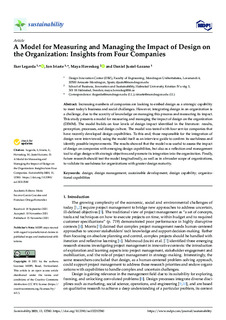
Izenburua
A Model for Measuring and Managing the Impact of Design on the Organization: Insights from Four CompaniesEgilea (beste erakunde batekoa)
Beste instituzio
Högskolan i HalmstadBertsioa
Bertsio argitaratua
Eskubideak
© 2021 by the authors. Licensee MDPISarbidea
Sarbide irekiaArgitaratzailearen bertsioa
https://doi.org/10.3390/su132212580Non argitaratua
Sustainability Vol. 13. N. 22. N. artículo 12580, 2021Argitaratzailea
MDPIGako-hitzak
design
design management
sustainable development
design capability ... [+]
design management
sustainable development
design capability ... [+]
design
design management
sustainable development
design capability
organizational capabilities [-]
design management
sustainable development
design capability
organizational capabilities [-]
Laburpena
Increasing numbers of companies are looking to embed design as a strategic capability to meet today’s business and social challenges. However, integrating design in an organization is a challenge, due ... [+]
Increasing numbers of companies are looking to embed design as a strategic capability to meet today’s business and social challenges. However, integrating design in an organization is a challenge, due to the scarcity of knowledge on managing this process and measuring its impact. This study presents a model for measuring and managing the impact of design on the organization (DIMM). The model builds on four levels of design impact identified in the literature: results, perception, processes, and design culture. The model was tested with four service companies that have recently developed design capabilities. To this end, those responsible for the integration of design were interviewed, using the model itself as an interview guide to confirm its usefulness and identify possible improvements. The results showed that the model was useful to assess the impact of design on companies with emerging design capabilities, but also as a reflection and management tool to align design with strategic objectives and promote its integration into the organization. Finally, future research should test the model longitudinally, as well as in a broader scope of organizations, to validate its usefulness for organizations with greater design maturity. [-]
Sponsorship
Diputación Foral de GipuzkoaProjectu ID
DFG/Programa para promover la generación de oportunidades, el valor diferencial y la sostenibilidad del tejido empresarial de Gipuzkoa 2020//GIP/Diseño Estratégico Participativo para el Fortalecimiento de las Empresas de Gipuzkoa II/ELKARDESIGN IIBildumak
Item honek honako baimen-fitxategi hauek dauzka asoziatuta:






















